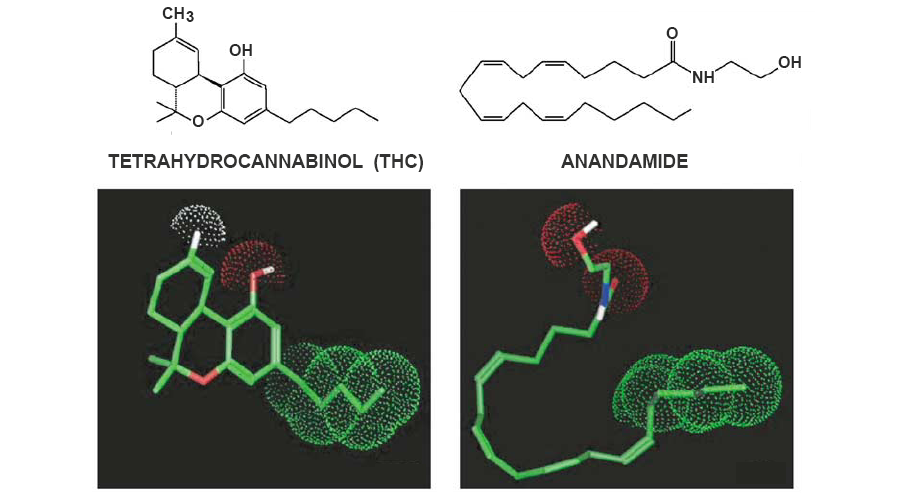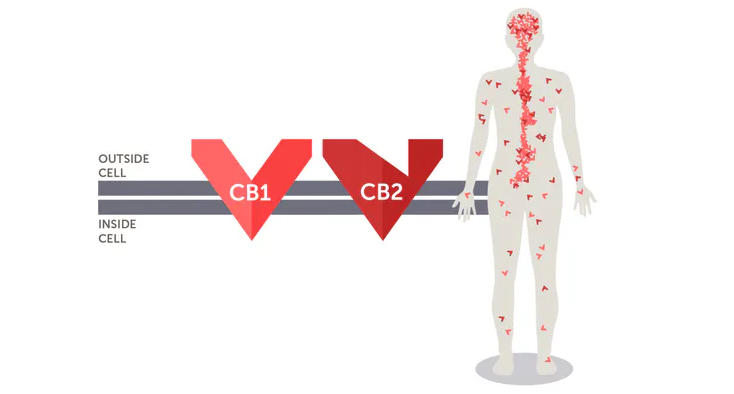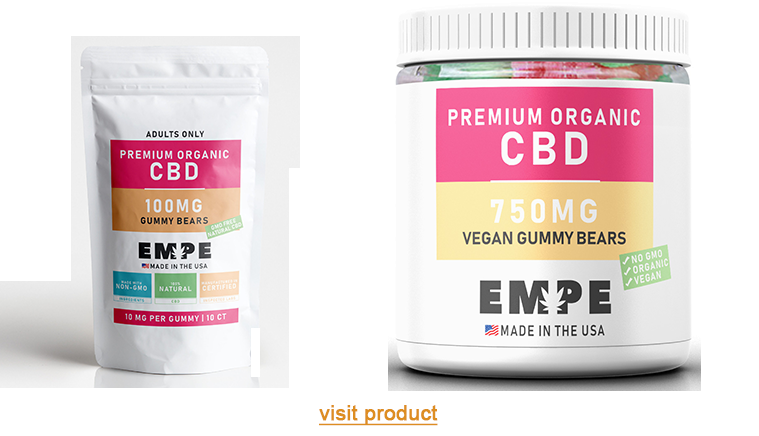Anandamide is a type of endocannabinoid — a type of molecule that works with the body’s endocannabinoid system, or ECS. The ECS exists to keep many of the systems of the body in equilibrium. Anandamide, known as the bliss molecule is vital to the ECS balancing your mood. Supplementing with CBD oil makes more anandamide available to the ECS, and results in an improved mood and a significant reduduction in the symptoms of anxiety.
Contents
What Is Anandamide?
Anandamide, also known as arachidonoylethanolamine, or AEA, is a fatty acid neurotransmitter — a chemical messenger that sends a message from a nerve cell to another cell. The recipient cell can be another nerve cell, or it can be a gland cell or muscle cell. Anandaminde is produced naturally in the brain, and occurs only in very low levels in a few foods.
Raphael Mechoulam Discovers Anandamide
Raphael Mechoulam, an organic chemist and professor of Medicinal Chemistry in Israel, along with researchers Dr. Lumir Hanus and Dr. William Devane, discovered anandamide in 1992 while researching the effects of THC on the brain. The human brain has receptors that are affected by THC — a chemical that isn’t produced by the body and comes only from external sources (namely, cannabis). Mechoulam theorized that it was unlikely that our bodies would have developed such important receptors if there weren’t also chemicals produced by the body that interacted with these same receptors. His theory was correct, and anandamide was the neurotransmitter he discovered.
Anandamide Naming
The newly discovered neurotransmitter was originally given the name arachidonylethanolamide, or AEA for short. Mechoulam and his team eventually settled on the shorter name anandamide, keeping the at the time very familiar AEA abbreviation.
Where did the name anandamide come from? The Sanskrit word ananda translates to bliss, or delight. At the time of this name choice Mechoulam had realized that this molecule as a powerful mood enhancer. That property is well-established, and to this day anandamide is often referred to as the bliss molecule.
The pronunciation of the word anandamide is pretty straightforward: “a-NAN-da-mide.”
Anandamide Molecule Structure
Molecules are often given names based on their molecular shape and structure — and that was the case when anandamide was first given the name arachidonylethanolamide.
The anandamide molecule has a 3-dimensional structure that is very similar to tetrahydrocannabinol, or THC. The two molecules are similar, but not identical, and their differences make anandamide more fragile than THC. So while both chemicals have a “feel good” property to them, anandamide doesn’t get a person “high” like THC does — anandamide breaks down rapidly so its effects aren’t as intense or long-lasting as THC.

The Endocannabinoid System (ECS) and Anandamide
When it comes to the health of your body’s cells, the endocannabinoid system, or ECS, is vital to maintaining cellular optimum performance. Anandamide’s actions take place in the ECS, so no discussion of anandamide is possible without a basic understanding of the endocannabinoid system.
What Is the Endocannabinoid System (ECS)?
In general terms, homeostasis is the tendency for interdependent elements to reach a stable equilibrium — any system generally works best when things aren’t too much of something, or too little or something.
When discussing homeostasis people sometimes mention the Goldilocks Zone, a reference from the classic fairy tale Goldilocks and the Three Bears. That story illustrates the importance of how oftentimes the best outcome of a situation lies in the middle of two extremes — Goldilocks found that the best temperature for porridge was not too hot, and not too cold, but rather, just right.
The ECS is a sophisticated network of molecules, enzymes, and receptors that together act to maintain homeostasis — cellular balance — within your body. Maintaining this Goldilocks Zone, or balance, creates an environment where cells, organs, and systems function in an optimal state.
Cannabinoids and Endocannabinoids
Cannabinoids are compounds that occur naturally in cannabis plants. A cannabis plant is made up of hundreds of compounds, of which about 100 are considered cannabinoids. The vast majority of cannabinoids are unfamiliar to the average person, but there are two that almost everyone has heard of: tetrahydrocannabinol, or THC, and cannabidiol, or CBD.
Cannabinoids can have a major influence on how the body’s organs and systems function — they can affect memory, appetite, mood, movement, and pain.
Endocannabinoids are compounds very similar to cannabinoids. The chief difference between the two is that while the body gets cannabinoids (such as THC and CBD) from an external source (plants), the body gets endocannabinoids internally (the endo in endocannabinoids means within). Cells in the body produce endocannabinoids such as anandamide.
The body makes use of cannabinoids and endocannabinoids via the endocannabinoid system (ECS).
Endocannabinoid System (ECS) Receptors
A key component of the ECS are the cannabinoid receptors (often referred to as endocannabinoid receptors) found on the surface of cells. The job of a cell receptor is to “listen” to what’s going on outside of the cell, and pass information about fluctuating conditions to the inside of the cell. The cell can then initiate a cellular response based on this information. The response will be different depending on what information the cell receives, but whatever its response it will be with the goal of keeping homeostasis, or cellular balance.
There are several types of cannabinoid receptors, but the two most important — and most studied — are the CB1 and CB2 receptors.
CB1 and CB2 receptors are both located on many types of cells throughout the body, but CB1 receptors are most abundant in the central nervous system, especially on neurons (brain cells), while CB2 receptors are more populous outside the central nervous system.

Cannabinoid receptors are an important part of the endocannabinoid system, but equally important are the endocannabinoids themselves. Endocannabinoids are small molecules that fit into cell receptors, acting as keys to unlock the receptors to allow environmental information into the cell so that the cell can react appropriately. The cell reaction will be one that contributes to regulating any number of functions, including neuro-protection, mood regulation, sleep, and appetite.
The terms cannabinoid receptor and endocannabinoid receptor are interchangeable because a receptor can operate with either cannabinoids or endocannabinoids. Recall that cannabinoids come from outside the body (THC and CBD are examples of cannabinoids) and endocannabinoids are created within the body (anandamide being the most prominent example of an endocannabinoid).
Anandamide Contributes to Happiness and Minimizes Anxiety
The endocannabinoid anandamide has been found to be responsible for a number of health benefits, including influencing pain perception, acting as an anti-inflammatory, and dilating blood vessels. The main function of anandamide, and the thing it’s most known for, is its ability to act as a neurotransmitter that affects mood. That’s why anandamide is referred to as the bliss molecule or happiness molecule, and its why increasing the body’s production of anandamide works to treat anxiety.
Anandamide and Anxiety Studies
Anandamide’s ability to lessen anxiety isn’t just a theory — many studies have demonstrated that this endocannabinoid does in fact help to treat people suffering from anxiety.
The 2014 Central Anandamide Deficiency Predicts Stress-induced Anxiety study revealed that anandamide can reduce anxiety resulting from psychological and environmental stressors. This study showed that among people with post traumatic stress disorder (PTSD), individuals with lower anandamide levels experienced stronger PTSD symptoms. Increasing patient anandamide levels served to reverse their stress-induced anxiety.
Research shows that when a person is exposed to a stressful situation, that person’s production of anandamide increases. A 2012 study published in Neuropsychopharmacology subjected 70 healthy volunteers to stressful situations such as mock job interviews. Measurements of the subjects’ anandamide levels pre-stress and post-stress revealed that following the stressful scenerio, anandamide levels increased significantly.
Feeling that traditional therapies and pharmaceutical drugs lacked effectiveness, in 2019 researchers at the University of Nottingham’s School of Biosciences conducted a study titled Cannabinoid Regulation of Fear and Anxiety. The study concluded that the endocannabinoid anandamide greatly regulated anxiety responses.
CBD Oil Increases the Body’s Levels of Anandamide
The best way to get more anandamide in your system is by taking CBD oil. The most interesting part of this method is that while CBD increase anandamide levels, CBD itself doesn’t contain anandamide.
Other Sources of Anandamide
Before jumping in with the details of how and why CBD oil works to increase your body’s anandamide levels, we’ll take a quick look at a couple of other ways people try to boost their anandamide. Methods that, unfortunately, don’t achieve good results.
Anandamide in Foods Like Chocolate and Cocao
When people are interested in a nutrition supplement — any supplement — the first thing they often do is perform some research to find out which food sources are the richest in that supplement. This is often a good approach, as certain nutrients can be found in high levels in certain foods. When a specific compound is made by the body, though, the approach often proves fruitless — the compound might not exist beyond minute levels in any food. That’s the case with anandamide.
Despite the fact that there aren’t any foods naturally rich in anandamide, if you do enough searching you’ll come across a lot of claims that dark chocolate contains anandamide, and that you should go ahead and indulge in this sweet treat to pump up your body’s anandamide levels. Or better still, buy bulk cocoa powder, as it’s the cocoa ingredient in chocolate that actually contains anandamide. Not so fast.
Cocoa does contain anandamide. Cocoa does not contain anandamide in any significant level. And there simply is no evidence that eating chocolate increases the concentration of anandamide in the body.
As a side note, while we’ll criticize the idea of choosing dark chocolate or cocoa powder as a good source of anandamide, we won’t criticize either as being a good supplement. Cocoa (and thus dark chocolate) is considered a very good nootropic — a compound that has cognitive-enhancing properties. Additionally, cocoa contains the amino acid L-tryptophan, which is a precursor to the “good mood” hormone serotonin. So, a little dark chocolate/cocoa might improve your mood — it just won’t be doing that by upping your anandamide levels.
Anandamide Supplements
If you read the above section, which makes clear there are no good food sources of anandamide, then you may already know why there are no good anandamide supplements on the market. Most nutritional supplements are extracts from foods and plants. It’s hard to come up with an anandamide supplement when there just isn’t much of this endocannabinoid found in nature.
If you search for anandamide supplements, the closest thing you’ll probably come across is bulk cocoa powder. The manufacturer might even label the supplement as Anandamide Powder which is, to the say the least, very misleading. You can buy a big bag of cocoa powder, but you won’t be getting a big dose of anandamide in that powder.
CBD Slows the Breakdown of Anandamide
If there are no readily available external sources of anandamide, how do people go about increasing anandamide in their bodies? The answer lies in the third main component of the endocannabinoid system — metabolic enzymes (cannabinoid receptors and endocannabinoids being the first two main components).
Metabolic Enzymes Break Down Endocannabinoids
Cannabinoids like THC and CBD, and endocannabinoids like anandamide, activate the cannabinoid receptors on cell walls to pass information to cells and set cells to work performing actions that keep cells, and the body systems, in homeostasis (in balance). When the cannabinoid or endocannabinoid has completed its mission of unlocking the cannabinoid receptor and passing the cell information, metabolic enzymes in the cell dispense with the cannabinoid or endocannabinoid.
The enzyme responsible for breaking down the anandamide endocannabinoid is fatty acid amide hydrolase, or FAAH. FAAH is a sort of cleanup molecule — when anandamide has completed its task, FAAH breaks it apart for reuse or disposal.
Anandamide is the bliss molecule — the main functions of anandamide are to help regulate mood, appetite and other crucial physiological functions. In short, more anandamide in your system means less anxiety.
It’s difficult to add additional anandamide to your body. But if you could lessen your body’s ability to break down existing anandamide, your body would have more anandamide — without actually adding more of it. Slow down FAAH’s actions, reap the benefits of anandamide for a longer time. It turns out that this is exactly what CBD does.
CBD Is an Anandamide Reuptake Inhibitor
An endocannabinoid reuptake inhibitor, or eCBRI, is a compound that limits the reabsorption, or breaking down, of an endocannabinoid.
In the case of anandamide, CBD is a reuptake inhibitor. CBD inhibits the production of FAAH. When your body has less FAAH, the breakdown of anandamide is slowed down significantly.
Overproduction of FAAH can lead to loss of appetite, irritability, anxiety, depression, and a number of other problems. Underproduction of FAAH reverses these same issues — appetite improves, and mood improves enough that symptoms of anxiety and depression can lessen or even disappear.
The bottom line: supplementing the body with CBD oil inhibits FAAH production, which in turn slows the breakdown of the mood-elevating anandamide endocannabinoid, which results in a lessening of anxiety.
Conclusion
Endocannabinoids are molecules that attach to receptors on cell walls. When an endocannabinoid attaches to a receptor it’s able to pass to the cell information on the status of events going on outside of the cell. The cell then takes appropriate action to work with changes in the body in order to maintain homeostasis, or balance. When an endocannabinoid’s work is finished, enzymes break it down for later reuse or for disposal.
This endocannabinoid molecule, cell receptor, and enzyme functioning is collectively referred to as the endocannabinoid system, or ECS.
Anandamide — the bliss molecule — is an endocannabinoid produced within the body. It acts as a neurotransmitter that positively affects mood, so increasing anandamide levels is a good treatment for anxiety, stress, and even depression.
There are no foods or plants that contain significant amounts of anandamide, so it’s difficult to boost anandamide from external sources. So instead of trying to add more anandamide to the body, the trick is to decrease the body’s ability to break down the anandamide already in the body. Supplementing with a compound that slows the production of the FAAH enzyme that breaks down anandamide does the trick. CBD is this compound, so taking CBD oil supplements keeps anandamide in the body longer, resulting in a better mood and less anxiety.





